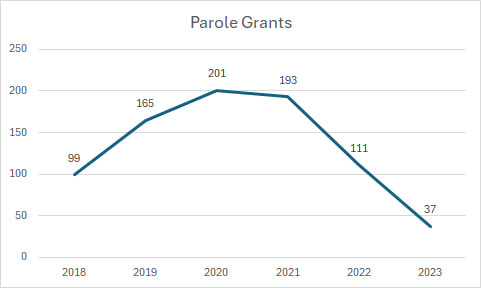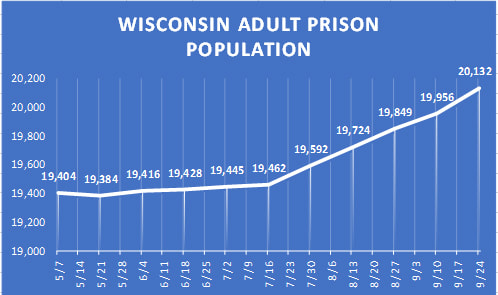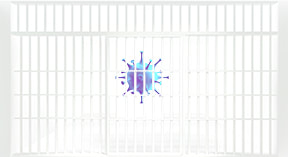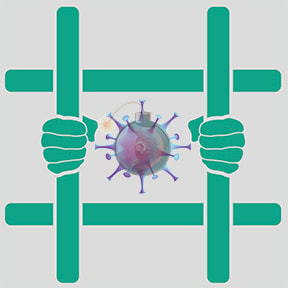|
By Margo Kirchner
Several organizations and activists this morning called on Wisconsin legislators and the governor to return 17-year-olds to the juvenile justice system and ensure that no 10-year-olds are eligible for the adult criminal justice system. The call came at a press conference outside the Milwaukee County Courthouse organized by Rev. Joseph Ellwanger on behalf of the Milwaukee Inner-city Congregations Allied for Hope (MICAH) Transformational Justice Task Force. Ellwanger was surrounded by more than two dozen supporters of youth justice reform, including two representatives from Wisconsin Justice Initiative. Ellwanger noted that the press conference was motivated by upcoming hearings in the case of a young boy who killed his mother when he was 10 years old. Under Wisconsin law, anyone charged with first degree intentional homicide, even a 10-year-old, is charged as an adult. (WJI guest columnist Roy Rogers previously wrote about the case here.) Hearings for a "reverse waiver" to juvenile court are set for next week in the young boy's case. Several speakers at the press conference referenced research indicating that the human brain does not fully develop until around age 25. Joshua Rovner of The Sentencing Project flew in from Washington, D.C. for the press conference. He noted that Wisconsin is one of only four states that treat all 17-year-olds as adults in the criminal justice system. (Wisconsin is aligned with Georgia, Texas, and Louisiana on that point.) Similarly, Wisconsin is one of just three states that allows a child as young as 10 years old to be charged as an adult for certain crimes, he said. Regarding the pending case, Rovner emphasized that “this is an elementary school child we are talking about.” Wisconsin’s Legislature and governor need “to fix these laws,” Rovner said. Emily Coddington, associate director of the Wisconsin Association of Family and Children’s Agencies, read a statement on behalf of the Raise the Age Coalition, a group of more than two dozen nonprofit and advocacy organizations pushing for legislation returning 17-year-olds to the juvenile justice system. “Wisconsin has failed to acknowledge what 46 other states already know: that raising the age (of adult prosecution) lowers recidivism rates, responds to often neglected mental health concerns and cognitive development research, provides a restorative and rehabilitative lens to youth justice, and begins to address racial disparities in the criminal justice system,” Coddington said. “We know that youth incarcerated with adults are 34% more likely to commit future crimes than youth served in settings designed to meet their unique needs, yet we continue to charge all 17-year-olds as adults,” she said. Wendy Volz Daniels, a clinical social worker and chair of the Felmers Chaney Advocacy Board, discussed how adults held by the Department of Corrections do not receive important anger management and cognitive behavior treatment until shortly before release. Several thousand individuals are on waiting lists for substance abuse and cognitive behavior treatment. “Sending children to the adult criminal justice system ensures that they will not get the treatment and rehabilitation that is needed,” she said. “Children cannot wait,” Daniels said. “Their needs are better served in the juvenile justice system, where they will immediately receive therapy and treatment,” she said. Two system-impacted individuals, including James Price, spoke about their own experiences as youth in the adult system and how children do not belong there. Price said that he “was absolutely scared” when he was age 14 in adult court in the building he now stood before, and he had to make adult decisions as a 14-year-old. Another system-impacted man said that when he was a teen and waived into adult court he “lost anything that looked like help,” including a social worker and psychiatrist who had been helping with his anger management. The Department of Corrections (DOC) called him “an overweight kid with PTSD” when he entered the corrections system, yet he did not receive necessary treatment for 27 years, shortly before his release. Other speakers included Sylvester Jackson, chair of the MICAH Transformational Justice Task Force; Dr. Kweku Ramel Smith, a psychologist and social justice advocate; and Dr. Richard Shaw, pastor of St. Matthew C.M.E. Church and MICAH president. Jackson emphasized that the DOC is “not prepared to deal with mental health and trauma” and “we should not forget that that’s a child,” referring to the pending case. He argued that society should not accept the charging of a 10-year-old as an adult Smith discussed how the education system has different levels of ages because of the vulnerabilities caused by mismatching age with setting, and the lack of such age differentiation in the adult corrections system. Shaw noted that God shows compassion and mercy, yet under current law “we have little to no compassion and mercy on children.” “We are challenging our government, we are challenging legislators, to change this law,” he said.
0 Comments
By Gretchen Schuldt The number of paroles granted last year was down 82% from a peak just three years earlier, Department of Corrections figures show. The number plummeted from 201 in 2020 to just 37 in 2023. What happened?
“We’re trying to figure that out, too,” said Mark Rice, Transformation Justice Campaign coordinator at WISDOM. The nonprofit has long been active in criminal justice reform efforts. DOC did not respond to a request for reasons behind the decline. Inmates eligible for parole are those who were convicted of crimes that occurred before the state's 1999 truth-in sentencing laws took effect. Those laws eliminated parole. The drop seems part of reduced efforts to lower prison populations, Rice said. Gov. Evers and DOC Secretary Kevin Carr took steps to cut populations during the Covid pandemic but now “it’s back to business as usual,” Rice said. The number of parole-eligible inmates declines each year as more die or serve out their sentences, but the drop in grants also appears linked to Evers' 2019 hiring and then de facto dismissal in mid-2022 of Parole Commissioner Chair John Tate II. The rise and fall in grant numbers neatly matches the dates of Tate’s employment. The Republicans ran ads attacking Tate's use of parole to release incarcerated individuals, Rice said. “Some of it was total lies” and there were “a lot of attempts to dehumanize people,” he said. Tate’s Parole Commission, which granted parole to some serious offenders, brought Evers under heavy political pressure as he sought reelection in 2022. First Evers intervened in May 2022 to successfully request Tate to rescind a decision to parole convicted murderer Douglas Balsewicz, who stabbed his wife to death in front of their children. Less than a month later, in June, Tate was gone after Evers asked him to resign. He was replaced by former State Sen. Jon Erpenbach, who assumed office in January 2023. Parole grant numbers followed the events: there were 43 grants in the first quarter of 2022, before the Balsewicz controversy blew up; then 31 in the second quarter, as the drama unfolded and Evers requested Tate's resignation. The number of grants dropped after Tate left to 19 in the third quarter and 18 in the fourth, according to DOC figures. Meanwhile, those who were paroled during Tate's tenure generally are doing well and making positive contributions in their communities, Rice said. "No human being is irredeemable," he said. Evers ran on pledges to reduce the prison population, but he and Carr have not done what is within their power, including commuting sentences and granting more compassionate releases to seriously ill inmates, he said. In Wisconsin prisons, Rice said, "The problem isn't understaffing. It's overpopulation." By Alexandria Staubach
The COVID-19 pandemic highlighted the phenomenon of lonely deaths in nursing homes and hospitals, but such lonely deaths continue in the Wisconsin prison system even post-pandemic. In the Wisconsin prison system, a terminal-illness diagnosis lands an imprisoned individual in Dodge Correctional Institution (DCI). While DCI principally serves as the reception center for all adult males entering the Wisconsin Department of Corrections (DOC) system, it also serves as the central medical unit for the male DOC population. It is where sentences begin and where life may end. Removal to DCI for terminal-illness care breaks bonds of friendship between incarcerated individuals that formed over years or even decades. “Once that person goes to DCI you know you may not ever see or talk to them again. You may not ever find out what happens to them,” said Roy Rogers, a former juvenile lifer in the Wisconsin prison system. (Rogers is now a data processor, a preentry and reentry liaison for The Community, and a WJI board member.) WJI inquired whether DOC permits video or any other form of visitation between terminally ill incarcerated persons and their incarcerated friends. “Wisconsin DOC has never allowed a person in our care to be on another person in our care’s visiting list,” John Beard, director of communications for the DOC, told WJI. “Dodge Correctional Institution is one of our institutions which has trained certified peer specialists within the population. So, if an individual requests peer support, they would have access to another person in our care who is trained to provide that,” Beard said. In other words, those who spend their last days as residents of the DCI infirmary have the companionship of staff or volunteers whom they do not know, but not of their friends from within the DOC. While incarcerated individuals may receive visitation with friends and family who are not incarcerated, the relationships formed between incarcerated persons are often their main relationships, said Rogers. Though in-person, peer-to-peer visitation among incarcerated individuals may not practically be feasible, DOC is equipped to and offers video visitation, according to its visitation policy. However, per Beard’s response to WJI, because the DOC does not permit persons in its care to be on each other’s visitation lists, the DOC does not permit video visits between individuals who are both incarcerated. Nearly 20% of the U.S. prison population is older than age 50 according to June 2023 Federal Bureau of Prisons statistics. Of the 21,171 persons incarcerated in the DOC as of May 31, 2023, nearly 24% were older than 50, including 46 individuals 80 or older. DCI’s infirmary unit holds 60 beds, with seven rooms dedicated to palliative care. According to the DOC, “a number” of incarcerated patients are residents of this infirmary. In June 2022 the oldest person incarcerated at DCI was 98 years old. The infirmary unit provides care to patients who require 24-hour or subacute nursing care. The palliative care program provides “a valuable service to patients with terminal illnesses, providing comfort and symptom management, when release to the community is not possible,” according to DCI’s 2022 Annual Report. By Gretchen Schuldt
The state's prison population is growing again after a long decline due to the COVID-19 pandemic. The number of adults incarcerated in state facilities declined to 19,381 on May 14, down significantly from the June 2019 level of almost 23,600 reported by the Wisconsin Policy Forum in its 2021-23 state budget brief. At the height of the outbreak DOC basically closed its doors to new inmates, shoving the problem of housing them downstream to local jails. And courts shut down or dramatically reduced operations, which also reduced the flow of inmates to prison. Then, this spring, prisons began accepting people again. The prison population ticked upward the week of May 21 and has increased every week since, according to Department of Corrections data. On Sept. 24, 20,132 people were incarcerated in the state's adult facilities. Current inmate numbers are likely to increase further as courts resume normal operations and more people are sentenced. Evers proposes $45.8 million for Milwaukee juvenile facility; DOC capital budget totals $119 million2/26/2021  Evers Evers By Gretchen Schuldt Gov. Tony Evers is proposing to spend $45.8 million on a new juvenile facility in Milwaukee, budget documents show. "The facility in this request will assist DOC (Department of Corrections) with working towards meeting the requirements of Act 185 and Act 8, which were created with the intent of eventually converting Lincoln Hills and Copper Lake Schools buildings into adult facilities," the proposed budget says. Lincoln Hills and Copper Lake are the state's secure juvenile prisons. The proposal is part of the proposed 2021-23 state capital budget. The governor recommended a total of $119.1 million in DOC capital spending. Milwaukee County last year held off on accepting $15.2 million in state funding to develop a secure residential center for juvenile offenders because the funding was inadequate. The county earlier sought $41.8 million from the state to increase the number of juvenile beds available. It later reduced the proposal to $26 million, and then $17.9 million. Even then, the county would have to kick in $2.7 million of its own funding. At the time he rejected the $15.2 million, County Executive David Crowley said that the funding gap and continuing operational costs "creates significant sustainability concerns,” according to the BizTimes. Crowley said Friday he was encouraged by the governor's general and capital budget proposals. The proposed youth facility would be about 59,000 square feet with "housing, food services, health services, education, counseling, vocational training, visitation, recreation, administrative services, and other supporting spaces for a population up to 32 juveniles," according to the budget proposal. It would employ about 70 people and cost $7.7 million per year to operate. Evers also rejected a $45.4 million funding request for a juvenile facility in Outagamie County. Other DOC capital spending recommended by Evers include the projects listed below. $18.6 million for a new health services unit at Dodge Correctional Institution. Dodge is the prison system's intake facility and in fiscal 2019 there were 7,178 intakes; the prison's population is more than 1,600. Each new inmate requires a minimum of 3 HSU appointments, and some can require four to eight appointments. The existing 12,300-square-foot facility "is very congested," the proposed budget says. "There are no medical observation cells or negative pressure rooms. There are several shared areas, such as the treatment room is shared with ER. There are staff doing data entry for electronic medical records in the X-ray room because there is no space for them." The new HSU would add 36,558 square feet.  Evers Evers By Gretchen Schuldt Gov. Tony Evers wants to expand expungement eligibility, do away with the plea-coercing charge of felony bail jumping, and legalize recreational marijuana. Many of his justice-related proposals are almost certainly doomed in the Republican-controlled state Legislature. But they are alive and well right now, and some, such as establishing a council or commission to review the state's sentencing structure, may not even need legislative approval. Here's a very quick look at some of his proposals. Most of the language is taken directly from the governor's budget narratives. Evers proposes:
 By Gretchen Schuldt The cost to counties to incarcerate juveniles at the Lincoln Hills / Copper Lakes youth prison would soar almost 50% by June 2023 and hit an annual cost of $299,300, according to the Department of Corrections budget request submitted this week. In a document largely of meaningful explanatory text, DOC justifies the requested increase in a single sentence: "Rates reflecting the cost of care in juvenile correctional institutions are set in statute and updated each biennium." The request comes as an agreement to close the scandal-plagued Lincoln Hills/Copper Lake facilities is teetering.
Lincoln Hills is for boys; Copper Lake is for girls. As of Friday, there were 68 boys held at Lincoln Hills and four girls at Copper Lake, according to DOC population figures. The state now charges counties $550 per day to house juvenile offenders at the secure facilities, the state's only juvenile prisons of their type. That amount is scheduled to increase to $615 per day on Jan. 1. The DOC's 2021-23 budget request seeks to increase that to $803 per day on July 1, 2021 and $820 per day on July 1, 2022. That would increase the annual cost of holding a single juvenile at the facility from $200,750 at the current daily rate to $299,300, an increase of $98,500. Overall, the department is seeking a budget hike of 4.5%, or $126.5 million over the biennium, from $2.8 billion to $2.92 billion, according to the budget request. The budget assumes an average daily incarcerated population of about 23,205 adults and 102 juveniles, according to budget documents. The budget request also includes increases of:
 Ross Ross By Shannon Ross I'll get right to the meat: Gov. Tony Evers and the Department of Corrections have far more than the two options they mentioned for releasing people. They mentioned in a statement only Certain Earned Release and Special Action Parole, but they can also employ Community Residential Confinement (DOC Administrative Code 327.04, which allows them to let parole-eligible people finish their time at home, on community custody), Emergency removal (325.01), which allows release during an emergency, and leave (326) (which allows them to grant furloughs to "nonviolent" individuals for extended periods to facilitate family reintegration and stability). They can talk to judges around the state about granting more sentence adjustments (two guys here with nonviolent crimes and histories were just denied, but get released within four months anyways). They can parole more people – many have somewhere to go and are set for release in the next year or two anyways, so what will it matter if they go home now after having served 20-30 years in prison? Most of all, Evers can commute the sentences of everyone with less than a year left to serve on their sentences (or less than six months or four months or whatever he wants). One of my cellmates is doing 5 months on misdemeanors right now. Does it make ANY DAMN SENSE to not commute his sentence amid this pandemic? The Certain Earned Release option he mentioned only applies to a smidgen of a crumb of a percentage of incarcerated people (I'd be shocked if it was more than .01%). Everyone else they mentioned releasing in press releases the last two weeks was from jails and Milwaukee Secure Detention Facility. They have effectively done nothing to address the potential danger in prisons. Before I address Evers' and the DOC's repeated puffery about what they are doing to keep us "persons in their care" safe, let me applaud them on the one thing they have done right: the FAQ and the transparent, up-to-date COVID status pages on the DOC website. The public and our loved ones are able to see in real time (supposedly) how many staff and incarcerated people have been tested, how many tested positive and at what facilities, and how many are awaiting results. DOC and Evers could have done their typical suppression of info under the comically North Korea-esque guise of security reasons, but they have endeavored for sunshine instead. Thank you. But it pretty much ends there.
They keep saying they have a plan, but judging from my experience and the hundreds of emails from incarcerated people statewide that I get in my role as manager of the most-widely read anti-mass incarceration publication in the state (thecommunitywis.wixsite.com/home), they seem like an infant learning to walk. Yes, they are providing two free phone calls a week (which, by the way, with the usurious phone rates they charge, is like stealing someone's car then claiming to be a good guy because you let them use it for free two times a week). But phone access has been curtailed at several facilities, especially where I am, and the calls commonly disconnect midway through (so much for a free 15-minute call when it hangs up on you within five minutes) and hardly anyone who was getting visits had problems with calling their loved ones in the first place (if you'll pony up $20-$50 for gas and snacks to visit someone in prison, you'll provide money so they can call you). The official line v. a description of life inside a Wisconsin prison: Same issue, different worlds4/10/2020
|
Donate
Help WJI advocate for justice in Wisconsin
|
Copyright © 2024 Wisconsin Justice Initiative Inc.
The Wisconsin Justice Initiative Inc. does not endorse candidates for political office. The Wisconsin Justice Initiative Inc. is a 501(c)3 organization.
The Wisconsin Justice Initiative Inc. does not endorse candidates for political office. The Wisconsin Justice Initiative Inc. is a 501(c)3 organization.










 RSS Feed
RSS Feed